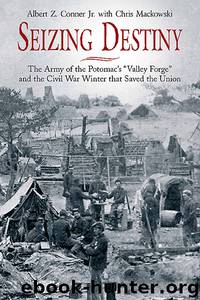Seizing Destiny by Albert Z. Conner

Author:Albert Z. Conner
Language: eng
Format: epub
Tags: HISTORY / United States / Civil War Period (1850-1877)
ISBN: 9781611211573
Publisher: Savas Beatie
Published: 2016-04-29T16:00:00+00:00
Maj. Gen. Oliver Otis Howard, called “Old Prayer Book” by some of his subordinates because of his strict religious faith, seemed an unlikely choice to lead the XI Corps. Hooker made the choice, in part, because he intensely disliked the other potential candidate, Maj. Gen. Carl Schurz. “I would consider the services of an entire corps as entirely lost to this army were it [the XI Corps] to fall into the hands of Maj. Gen. Schurz,” Hooker contended. LOC
Another important reform of the army’s ordnance service took place on March 25 under G. O. No. 30. Whether Hooker aimed at readiness for a move or firming-up ammunition- and arms-handling procedures, the forward thinking order required basic loads of ammunition be kept on hand: “Infantry: 140 rounds with that in the cartridge boxes [40 rounds]; Cavalry: 100 rounds for carbine and 40 rounds for pistol with that in the cartridge boxes; and Artillery: 250 rounds with that in the ammunition chest.” The 20 rounds previously carried by infantrymen in their knapsacks would be expended in due course, perhaps through marksmanship training, but not replenished. Thereafter, those rounds would be issued on the eve of battle and carried in pockets. After covering the minutiae, the order fixed the main responsibilities on division ordnance officers, who were relieved from other duties to report to division headquarters.
Another valuable innovation resulted: reserve ammunition wagons would be marked with corps and division symbols, and infantry, cavalry, or artillery ammunition wagons would be “color-coded”—representing the branches with horizontal blue, yellow, or red stripes respectively. The army’s main ammunition depot would be marked by a crimson flag marked “Ordnance Depot, U.S.A.” On the march, when brigades were dispersed, division ordnance officers could detach stores to brigades. Care would be given in battle to deploying ammunition trains to facilitate resupply. Divisions would draw on the army ordnance depot for resupply munitions. Unserviceable and condemned ammunition would be turned in through regimental quartermasters. Division ordnance officers would have a staff with an acting ordnance noncommissioned officer and a clerk. Extra-duty men on ordnance duty would report to him and be kept on his extra-duty rolls. Now, clearly marked mobile resupply ammunition wagons could be moved closer to the units and pack trains.20
Another reform came from up the tracks in Washington. Railroader Herman Haupt sent Hooker a copy of instructions he had cut to his chief engineer, A. Anderson. “You will take measures to have everything in readiness to meet the wishes and second the movements of the commander of the Army of the Potomac,” he wrote, “sparing no labor or necessary expense to secure the most effective action when called upon, and to provide the materials and men necessary for the purpose.” Significantly, Haupt ordered Anderson to assemble the necessary force to support movement, apply to the army commander for details of soldiers, and gain support from the army’s chief quartermaster for transportation of all kinds and forage for his animals. “When active forward operations are resumed,” Haupt added, “the
Download
This site does not store any files on its server. We only index and link to content provided by other sites. Please contact the content providers to delete copyright contents if any and email us, we'll remove relevant links or contents immediately.
| Africa | Americas |
| Arctic & Antarctica | Asia |
| Australia & Oceania | Europe |
| Middle East | Russia |
| United States | World |
| Ancient Civilizations | Military |
| Historical Study & Educational Resources |
1861 by Adam Goodheart(1033)
Smithsonian Civil War by Smithsonian Institution(993)
Abraham Lincoln: A Life, Volume 2 by Michael Burlingame(949)
The Fiery Trial by Eric Foner(924)
Ulysses S. Grant by Michael Korda(913)
Battle Cry of Freedom by James M. McPherson(907)
Rock of Chickamauga(906)
Rebel Yell: The Violence, Passion, and Redemption of Stonewall Jackson by S. C. Gwynne(899)
101 Things You Didn't Know About Lincoln by Brian Thornton(891)
Abraham Lincoln in the Kitchen by Rae Katherine Eighmey(845)
This Republic of Suffering: Death and the American Civil War by Drew Gilpin Faust(826)
Bloody Engagements by John R. Kelso(805)
Union by Colin Woodard(788)
Lincoln's Lieutenants by Stephen W. Sears(780)
Leaves of Grass by Walt Whitman(778)
The escape and suicide of John Wilkes Booth : or, The first true account of Lincoln's assassination, containing a complete confession by Booth(752)
1861: The Civil War Awakening by Adam Goodheart(734)
Rise to Greatness by David Von Drehle(714)
The Fiery Trial: Abraham Lincoln and American Slavery by Eric Foner(713)
